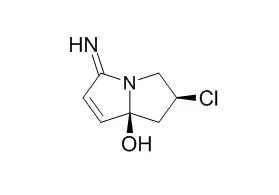| In vivo: |
| Supplements to the 2nd Edition of Rodd's Chemistry of Carbon Compounds, 1975, Pages 15–69 | | Chapter 8 – Five-membered monoheterocyclic compounds: Alkaloids (continued): Pyrrolizidine alkaloids[Reference: WebLink] | Additional plant families that are now known to contain pyrrolizidine alkaloids are the Apocynaceae, Celastraceae, Euphorbiaceae, Ranunculaceae, and Scrophulariaceae. The mass spectra of pyrrolizidine alkaloids, 13C nuclear magnetic resonance spectrometric assignments, ultraviolet spectra of 20 pyrrolizidine derivatives, and infrared spectra of 25 pyrrolizidine esters are the spectroscopic studies presented in this chapter.
METHODS AND RESULTS:
Analytical methods, such as ion exchange resins, high performance liquid chromatography (HPLC), gas–liquid chromatography–mass spectrometry, and reverse-phase HPLC are discussed. The chapter discusses the preparation and properties of necines of various kinds, such as monohydroxylated derivatives, unhydroxylated derivatives, dihydroxylated derivatives, and trihydroxylated derivatives. The chapter also illustrates the synthesis of necic acids that include C6-acids, C7-acids, C8-acids, C9-acids, and C10-acids. The structural confirmation of various compounds, such as nitropolyzonamine from the defensive secretions of the millipede Polyzonium rosalbum, peduncularine found in Aristotelia peduncularis, Clazamycin A and Clazamycin B isolated from Streptomyces species are characterized.
CONCLUSIONS:
The chapter discusses the toxic effects on humans caused by ingestion of pyrrolizidine alkaloids. Hepatotoxicity, carcinogenicity, and accidental poisoning occur on consumption of foodstuffs contaminated with seeds of various plants that produce pyrrolizidine alkaloids. |
|






 Cell. 2018 Jan 11;172(1-2):249-261.e12. doi: 10.1016/j.cell.2017.12.019.IF=36.216(2019)
Cell. 2018 Jan 11;172(1-2):249-261.e12. doi: 10.1016/j.cell.2017.12.019.IF=36.216(2019) Cell Metab. 2020 Mar 3;31(3):534-548.e5. doi: 10.1016/j.cmet.2020.01.002.IF=22.415(2019)
Cell Metab. 2020 Mar 3;31(3):534-548.e5. doi: 10.1016/j.cmet.2020.01.002.IF=22.415(2019) Mol Cell. 2017 Nov 16;68(4):673-685.e6. doi: 10.1016/j.molcel.2017.10.022.IF=14.548(2019)
Mol Cell. 2017 Nov 16;68(4):673-685.e6. doi: 10.1016/j.molcel.2017.10.022.IF=14.548(2019)